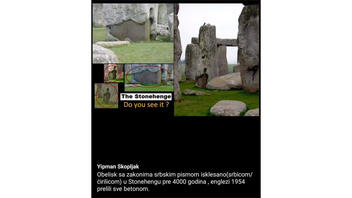
Was a 4,000-year-old obelisk with laws inscribed in Serbian found at Stonehenge, in the United Kingdom? No, that's not true: The first written testimonies of the Serbian language date back to the late 10th and early 11th century, thousands of years later than the alleged obelisk. Furthermore, there are no writings on the monuments at Stonehenge.
The claim originated from a video (archived here) on TikTok published on November 13, 2023. It opened (translated from Croatian to English by Lead Stories staff):
An obelisk with laws inscribed in Serbian (Serbian/Cyrllic alphabet) carved at Stonehenge 4,000 years ago, the English covered it all with concrete in 1954.
This is what the post looked like on TikTok at the time of writing:
(Source: TikTok screenshot taken on Fri Nov 17 07:35:49 2023 UTC)
The Hilandar fragments are the oldest evidence of the Serbian language on paper and the oldest text written in Cyrillic script preserved to this day. The Hilandar fragments are from the end of the 10th and the beginning of the 11th century. They include two sheets. Their content is parts of the sermon of St. Cyril of Jerusalem. They were found in 1844 by a Russian philologist V.I. Gligorovič in the Serbian Hilandar Monastery in Mount Athos, Greece, more precisely in a small store in the tower of St. Sava. He donated them to the Novorossiysk State Library in Odesa, Ukraine -- today the Odesa State University.
Stonehenge is a prehistoric stone circle monument located on Salisbury Plain in England. It was built in six stages between 3000 and 1520 BCE. Early Bronze Age carvings were found using a laser-scan survey. The carvings portray axe heads and daggers. There are no writings on the monoliths. While it is still unclear who built Stonehenge, some archaeological evidence suggests that the first stages of the building were made by early Mesolithic hunter-gatherers. The DNA analysis of bodies that were buried near the site indicates that people participating in the building process may have come from Wales or the Mediterranean.











